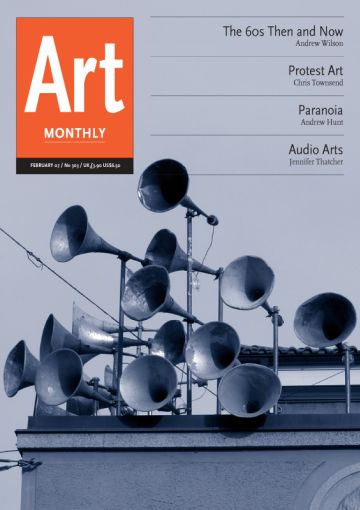Feature
Protest Art
Chris Townsend asks if protest art can be effective
Towards the end of an interview with Hal Foster in October, about the critique of the culture of military spectacle that characterises late capitalism as presented in its book Afflicted Powers, the Retort collective (Iain Boal, TJ Clark, Joseph Matthews, Michael Watts) got around to discussing art. ‘We look around at the actually existing art world of the Empire and see no reason to expect much in the same vein. We shall refrain from putting alongside Mohammad Sidique Khan’s last testament a brief listing of the themes and styles of this week’s gallery offerings in New York and Los Angeles, or a sample of the “ethical stances” of their reviewers.’
Retort’s analysis of the current historical crisis (the war in Iraq, the wider confrontation between globalising neoliberal economics on the one hand, and religious fundamentalism and pan-nationalism on the other, which offer a desperate resort and illusory hope for those disenfranchised and disempowered by the effects of western capital) is incisive and important for those of us who hope to understand where we stand in relation to the world, and for those who might hope to do something about it. Given that one of the collective’s members, TJ Clark, is among the most prominent art historians of the last 40 years, those of us who share his investment in the visual arts necessarily pay close attention to these comments and wonder why there is not at least some comment that is less scathing. Surely contemporary art has something to say about contemporary events? Does art not offer a way of intervening in the world: an extensive and effective form of protest and dissent, a mechanism that might foretell or initiate change?
So we might like to imagine: it is Modernism’s legacy of art as utopian social agent; it is the promise of the public sphere that constitutes a functioning democracy. But as Retort frames it, the problem is not that this space is now necessarily emptied as a resource with which to critique or analyse spectacle, or that neoliberalism might prohibit such critique, but that empirically it seems those fields where we might expect to find it are devoid of either content or capacity to effect change. We might go further and suggest that the space of art, ‘the actually existing art world’, is now almost wholly complicit with and integrated into the economy and society of what Retort calls ‘the Empire’. I am not referring here to ‘Empire’ as a globally dominant nation state – though the US is certainly implicated in the new form of global effects that capitalism takes as an administrator and enforcer – but rather to that juridical and economic complex of supranational corporations and agencies outlined by Michael Hardt and Antonio Negri. Far from offering the possibility of historical critique or genuine dissent, contemporary art largely exists, through its market value, as one of those exclusive niches for conspicuous consumption that guarantee status to the newly enriched, demonstrate the fulfilment of capitalism’s promise, show that you are living the good life. How many Lear jets flew down to Miami, or was it Basel? How many celebrities? How many parties? And was not the art on display only marginally less grotesque and vapid than Paris Hilton and her ilk? What we once thought of as a successful model for protest art was in fact – as it reached its peak in the early 70s in a chorus of four-part harmony against the Vietnam war – the paradigm for the incorporation of critique into the culture industry. This was the point at which a culture of dissent became a commodity form of late capitalism. As Alain Badiou observed recently in ‘Fifteen Theses on Contemporary Art’, ‘sure of its ability to control the entire domain of the visible ... Empire no longer censures anything. All art and all thought is ruined when we accept this permission to consume, to communicate and to enjoy.’ ‘Protest art’ as part of this economy may itself be an emblem of historical catastrophe.
Retort’s response shows that they have no hope for the ‘art world of the Empire’. This does not, seemingly, preclude art from making some contribution to analysis, dissent or even forms of physical resistance. Indeed Retort’s own, somewhat predictable, video work in the recent Seville Biennial suggests that they perhaps see themselves as operating at best in a sphere beyond the Empire’s influence, at worst in one that offers them a qualified degree of freedom and effect. Retort’s analysis of the present moment is, of course, not the only one available, but it is one to be taken seriously, on account of the quality of its scrutiny, and because it refuses false hope. If we are to find a model by which art can comment on, and intervene in, the moment through which we live, it has to be an art that acknowledges, and indeed emerges from, the experience of defeat. It also has to be an art that forgets about the immediate emotion of protest. As Slavoj Zizek remarked in ‘Neighbours and Other Monsters: A Plea for Ethical Violence’, ‘pitiless self-censorship is a sine qua non of emancipatory politics’. Millions marched worldwide to protest the Iraq war, before it happened. Artists made inspired, genuinely creative works of protest and even managed to stage not-so-impromptu exhibitions: at Berkeley Art Museum Fred Wilson’s Aftermath, 2003, took artefacts from the Hearst Museum of Anthropology to stage the impression of a battlefield that concatenated centuries of slaughter. Those protests were ignored; such is the nature of democracy. What went wrong? In a spectacular society was the spectacle of millions marching – the largest demonstration London had ever seen, for example – simply not enough? According to Retort we inhabit a society where ‘a picture, in the present condition of politics, is itself, if sufficiently well executed, a specific and effective piece of statecraft’. What does it say about the state of picture-making as art that the only images that now seem to have political effect are of jets flying into the World Trade Center, of hooded Iraqi detainees wired up to what remains of their shattered country’s electricity supply, or of the delicate propriety of Saddam Hussein’s execution?
The answer might be that these were images that ruptured the spectacle of our culture, whereas most art today reinforces that spectacle. Stockhausen was, perhaps, not completely barmy when he described the WTC atrocities as a work of art. There was a level at which Muhammad Atta and his first disillusioned and then deluded companions were undertaking a task that art had set itself, within Modernism, and then discovered itself incapable of achieving: the task of making a rent in the fabric of culture that revealed, once and for all, the incipient alienation created by that culture. An act of cultural suicide, if you like; the ultimate protest. It was as if Georges Bataille, at his most pointlessly nihilistic, had decided to live out André Breton’s surrealist wet-dream of running down the street, firing a revolver at random. But then members of al-Qaida aren’t playing the avant-garde game of shocking daddy while living off his trust-fund. The rupture that the inferno and collapse of the WTC represented was for real, even if as event its images relied, like art, on symbolic value. What al-Qaida understood, better than any western critic, was that those images would not then be attentively analysed, understood critically – because the culture of spectacle precludes such response – but rather responded to: emotionally, sentimentally, in the manner of those Hollywood movies that are the apotheoses of spectacle. And those responses – whether short-term military interventions or the longer-term demonising and consequent alienation of Muslim populations in western countries – would serve their purposes long after the twin towers had been replaced and the money markets had got over the hiccup in their operations.
If there remain forms of culture that allow some critical purchase on the present, they are perhaps relics. They are objects that, either through abandonment by or resistance to the culture industry and the economy of art, occupy a marginal space. They may be objects that, through the historical accumulation of aura, have acquired an iconic status that gives them the quality of a relic. Stripped of use value they cannot quite yet be disposed of, for reasons indefinable but yoked to memories of an outlived culture. Picasso’s Guernica, that moving symbol of anti-war protest from an earlier age, remains one of the most potent images we have of the present conflict. Or, rather, Guernica’s veiling over, its disappearance, becomes the telling symbol. At American insistence the copy that hangs outside the debating chamber of the UN Security Council was curtained over before the official statements were made announcing the hijacking of UN resolutions by the US and the UK as pretence for the legitimacy of their invasion of Iraq. The black comedy of this event, the concealment of the image more telling, perhaps, than its presence, revealed a curious ineptitude in managing the symbolic environment of war. Of course, this moment of embarrassment did not prevent the invasion, any more than Guernica in 1937 could prevent the unfolding conflict with fascism. But beyond the grim ‘pleasure’ of its absurdity, the Guernica incident was usefully illuminating. It showed that there might be other rents in the fabric of spectacle; that ‘image management’ was not all it should be. There would be other rents, in particular the Abu Ghraib photos, to suggest that there were, if not sites of resistance to be found within the images themselves, points at which the authorised, circumscribed meaning of mass-media circulation could be short-circuited or even re-routed.
None of this amounts to a conventional ‘protest art’. If Guernica taught anything in 2003 it was that the images and culture which we could use would be those made redundant by the culture industry, or those which deliberately rendered themselves unserviceable. This might explain Retort’s resort to Milton’s Paradise Lost for a governing metaphor of the condition of Empire and of those who would oppose it. We should, indeed ‘Consult on how we may henceforth most offend Our Enemy’ – just as Bush, Cheney and their cronies did, even before the destruction of the World Trade Center. Maybe there are other useful resources within the legacy of a forgotten culture that explain the present better than any new product ever will. If we want to understand what we will never see, what will never be acknowledged – the ‘water-boarding’ and other novelties practised in the name of freedom – then we might do worse than start with Titian’s The Flaying of Marsyas, for some critics an allegory of a real torture that the artist did not witness. Precisely because it cannot be contemplated for very long without feeling uncomfortable at human impotence before the power of gods, Marsyas tells us a great deal about the contemporary exercise of authority and pain.
Are there still spaces inside contemporary life where artists might make new art that somehow protests, effectively, against the state of things? We’d like to think so, not least because they offer a form of comfort. We can feel as if we are legitimate participants in a democracy without having to expose ourselves. We can salve our consciences without worrying about our lack of effect. There is, after all, the precedent of Vietnam – the US’s previous Iraq. Back then the protests of artists really helped to illuminate the consciousness of Americans; the art strikes and Frank Stella lapel badges, the museum closures and Warhol’s campaign posters for McGovern really turned things around. I suspect that former members of the Viet Cong and the North Vietnamese army might have a more sanguine view about their relative effectiveness compared with that of Students for a Democratic Society. But even if this were true, if we believe Iraq to be Vietnam all over again, the analysis is so profoundly mistaken that our protests, and our belief in the effectiveness of protest, offer comfort to those who would colonise on behalf of, and through, globalising capital; those who would break international law; those who would torture in the name of democracy. Such an art changes nothing, and tells us nothing. If anything it aids rather than afflicts those powers we oppose because it offers the illusion of effective free speech and the right to protest.
Examples of such work abound. Gary Hill’s recent Frustrum gives us a digital Eagle as symbol of America, trapped inside power lines. Just to really make the point that it is all about the struggle for Mother Nature’s resources and that we really need to get out of our SUVs, there is a big lake of specially refined oil in front of it. Not, you note, the stinking stuff that comes out of a well; that oil workers somewhere other than the art world have to deal with. Blood for Oil is an easy chant but a weak analysis of the current needs of military-industrial capitalism (or, for a British audience, of the cynical pieties of ‘spreading democracy to failed states’ that Blair provided). Hill is a decent man registering his protest as an artist within the bounds of what he knows, just like Neil Young when he sings ‘Let’s Impeach the President’.
The most effective image of anti-war protest has not been an artwork, but a pixellated picture of amateur torture. However, juxtapose the most infamous of the Abu Ghraib pictures with the sculpture Memorial (Serie Democracia), 2005, by Spanish collective El Perro, which shows a skateboarder poised upon a pyramid of crouching, hooded figures. Clearly what went on in Abu Ghraib is at issue here, but there is something more. Memorial analyses what Hannah Arendt called the banality of evil, which, we used to think, referred only to the actions of our enemies. El Perro’s sculpture is not simply a response to the exposing of torture and degradation, it is the beginning of an analysis of how what has been substituted for a culture of thought, namely the practice of mindless recreation (and by implication the wider culture of the substitution of play and mimesis for action and experience) both enables and enacts torture and degradation. Memorial tells us more about Iraq than any easy revelation of the criminality of our leaders in a poem or a poster, than any easy equation about resources and the exercise of power. The problem that comes after making such a work is that of finding a venue that will allow its analysis some effect. To find such a space for clear expression might demand a marginality that professional western artists aren’t yet ready for; the self-censorship that Badiou and Zizek call for might not only be a matter of how things are said, but of where they are spoken.
Seville Biennial ran from October 10 2006 to January 8 2007.
Chris Townsend is a senior lecturer in the department of media arts, Royal Holloway, University of London.
First published in Art Monthly 303: February 2007.









